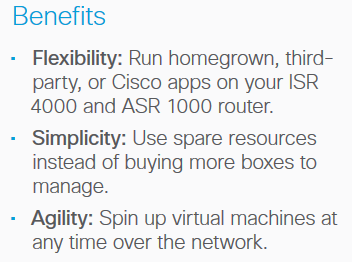Something New for KVM (Kernel Virtual Machines) App Hosting on a Cisco Router
Use Spare Router Cycles to Host Linux VMs
In this summer, Cisco introduced a capability that we quietly rolled out in a software release last November (IOS XE 3.17). You can now host your own custom or third party KVM lightweight applications directly on your ISR 4000 or ASR 1000.
Kernel-based Virtual Machines, the KVM, are the standard virtualization technology in the embedded Linux world. If you’re writing applications to be hosted across a network, odds are you’re already using it. The ability to virtualize across the network is a key aspect of Cisco DNA so this capability dovetails very nicely with the larger solution for enterprise environments.
Get the Most from Your Branch Router
Many lightweight applications and network functions needed in a modern network or branch office are available as virtual machines (VM). If you need to host some of these functions in the network, use your Cisco router to do it instead of deploying a dedicated appliance at your branch site.
You’ll reduce complexity and cost by making use of spare compute horsepower that’s already in your router. Very efficient.
Run the Apps You Need...
Use the Cisco 4000 Series Integrated Services Router (ISR) and ASR 1000 Series Aggregation Services Router to host not only Cisco apps, but also third-party and homegrown Linux-based apps. These routers’ Cisco IOS XE operating system supports the Kernel-based Virtual Machine (KVM), a virtualization infrastructure for the Linux kernel that turns it into a hypervisor.
Both routers use a customized high-performance data plane for forwarding and manipulating packets. The control plane is entirely Linux running on an x86 Intel CPU. We designed the routers with extra CPU capacity for hosting VMs.
You can also turn to the Cisco 4000 Series ISR and ASR 1000 Series to host other network functions that can be deployed as VMs, including:
• Windows domain controller
• Print servers
• Network analytics
• Network functions such as WAN optimization (Cisco WAAS), intrusion detection and prevention (Snort IPS), and visibility and security intelligence (Cisco Stealthwatch Learning Network License)
Hosting those VMs directly on your existing physical router makes a whole lot of sense.
...With the Performance You Expect
VMs are not hosted in the data plane of the router, so there is no performance impact on packet forwarding or feature processing. Critical control plane functions run at a higher priority than hosted VMs.
This is industry-standard Linux virtualization at its finest.
The full PDF file from http://www.cisco.com/c/dam/en/us/products/collateral/routers/4000-series-integrated-services-routers-isr/at-a-glance-c45-737753.pdf
More Related Topics





/image%2F1490247%2F20190327%2Fob_8eebea_networking-for-digital-intro.png)
/image%2F1490247%2F20190117%2Fob_9629a3_new-cisco-9000-family-members.png)
/image%2F1490247%2F20181221%2Fob_c62717_explore-the-nexus-400g-portfolio.png)
/image%2F1490247%2F20181009%2Fob_98a4cb_40-100g-qsfp-bidi-transceiver-module.png)
